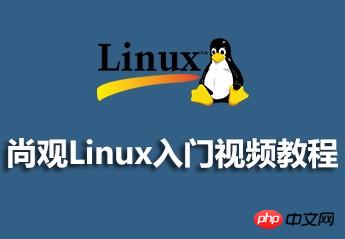
Linux is a Unix-like operating system that is free to use and spread freely. It is a multi-user, multi-task, multi-thread and multi-CPU operating system based on POSIX and UNIX. It can run major UNIX software tools, applications and network protocols. It supports 32-bit and 64-bit hardware. Linux inherits the network-centric design philosophy of Unix and is a multi-user network operating system with stable performance.
The Linux operating system was born on October 5, 1991 (this is the first time the date was officially announced to the outside world). There are many different Linux versions of Linux, but they all use the Linux kernel. Linux can be installed on a variety of computer hardware devices, such as cell phones, tablets, routers, video game consoles, desktop computers, mainframes, and supercomputers.
"Shangguan Linux Getting Started Video Tutorial" explains to everyone the knowledge points about getting started with the Linux operating system, so that everyone can learn from the beginning. The knowledge points are explained in detail and the content is comprehensive.

Video playback address: http://www.php.cn/course/523.html
The teacher’s lecture is vivid and vivid , witty, witty, and touching. A vivid metaphor is like the finishing touch, opening the door to wisdom for students; an appropriate humor brings a knowing smile to students, like drinking a glass of mellow wine, giving people aftertaste and nostalgia; a philosopher's aphorisms, cultural references Proverbs are interspersed from time to time in the narration, giving people thinking and warning.
The important and difficult points to learn in this video:
My Linux needs
What is discussed here is my demand for online Linux machines, so only stable releases are discussed, and It's a more conservative version. For example, CentOS 7's xfs will not be discussed. This does not mean that xfs is not good, but that my current Linux level requires updating a lot of xfs knowledge, and it takes time to master it. CentOS 7 has also eliminated commonly used commands such as ifconfig and netstat. Let's use CentOS 6 as the basis to talk about my basic needs for Linux.
Minimum installation
CentOS has a minimal version, which removes many services compared to the standard version, such as Network Manger. After installing the minimal version, the network configuration requires full manual configuration file configuration by the admin. of. I personally think this is better, because we can better understand how the Linux kernel treats these configuration files, which ones are really needed by the kernel, and which ones can be directly modified to change the performance of the kernel. For some necessary monitoring tools, you can complete it through yum install. The standard version is more suitable for daily practice. As an online machine, it is better to minimize the installation, so that services that cannot be opened are not opened, and ports that can be closed are closed. This way, valuable hardware resources can be left for applications. Programs can also be more secure because the entry point for attacks is through the network.
Secure enough
In addition to closing ports that can be closed and services that cannot be used, security also requires that specific services can only access specific content. Even with a root account, inaccessible files and folders are still inaccessible, let alone inoperable. Because it is very possible for an attacker to obtain root privileges, there is basically nothing they can do at this time. After SELinux is turned on, specified services can only access specified resources without modifying SELinux.
Resource on-demand scheduling
We often encounter such a problem. Assume that the disk sda is mounted to the /var directory, but due to too many logs or other factors such as uploaded files, the The hard disk is exhausted, and if you create another sdb disk, it cannot be mounted to the /var directory. In fact, the lvm that comes with Linux has solved this problem, and CentOS uses lvm to manage disks by default. We need to learn how to format a hard disk as lvm, and then mount it to the corresponding directory. We can add a hard disk and automatically expand it before the space is eaten up.
Network Monitoring
To put it bluntly, it is to make good use of iptables locally in Linux to plan which network traffic to serve and which network traffic to discard. And when networking, you need to use a router to create a gateway. When encountering network problems, use netstat to check network access abnormalities. There is a lot of content in the network, including various parameters, TCP/IP protocol stacks, etc., but often the problem lies in the network, so we need to pay high attention to it.
The above is the detailed content of ShangguanLinux introductory video material sharing. For more information, please follow other related articles on the PHP Chinese website!




